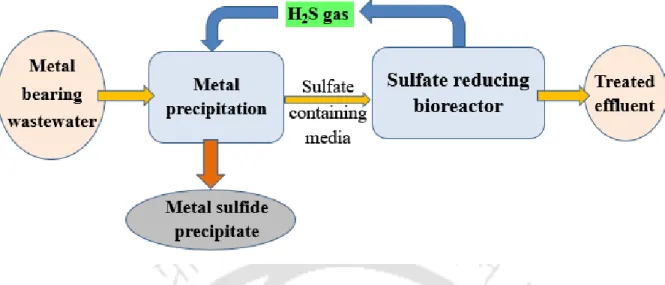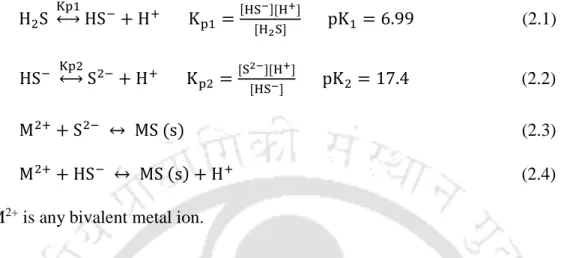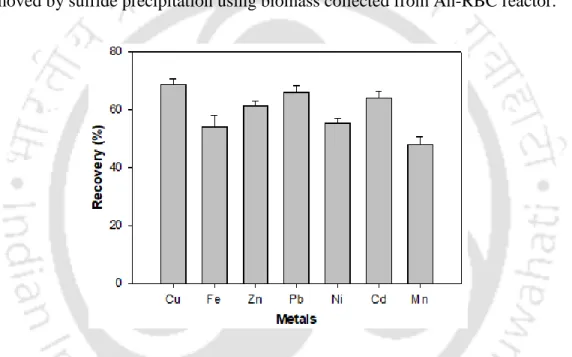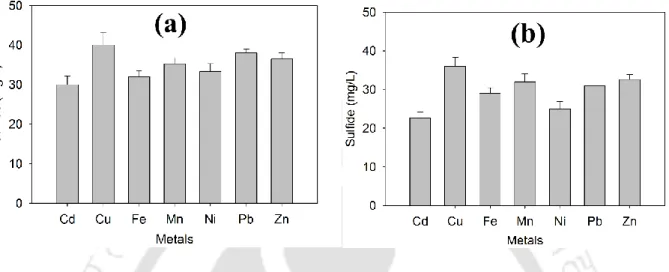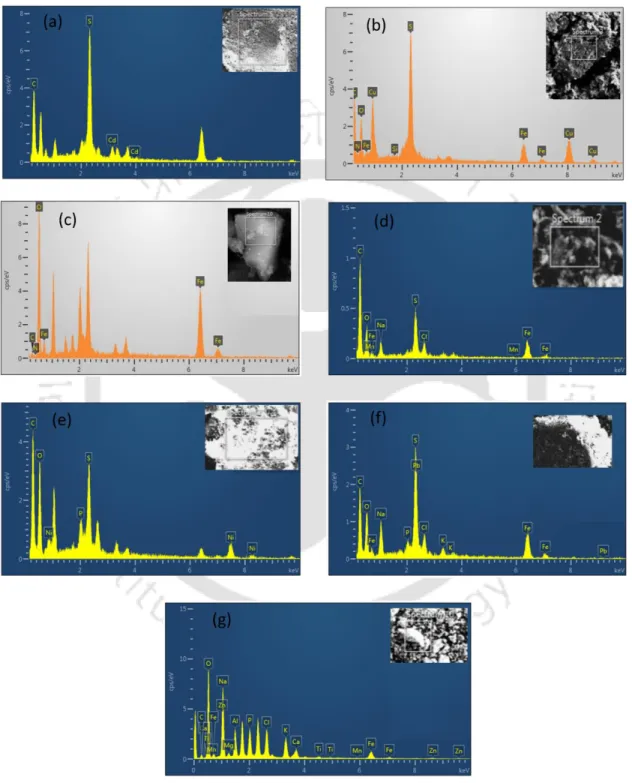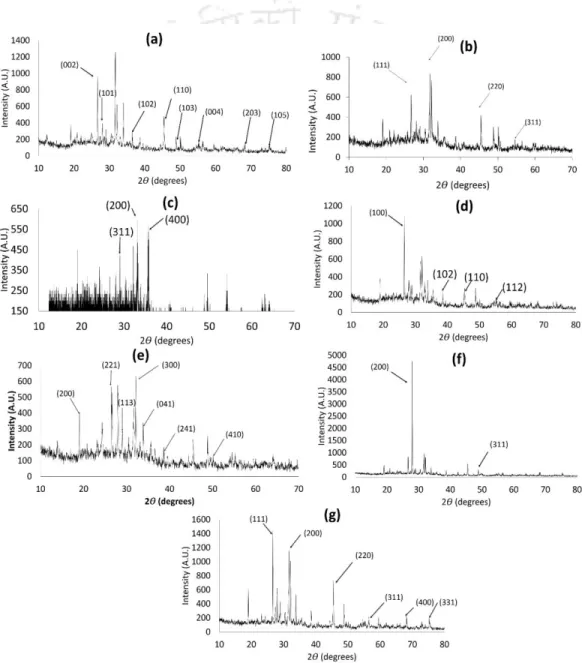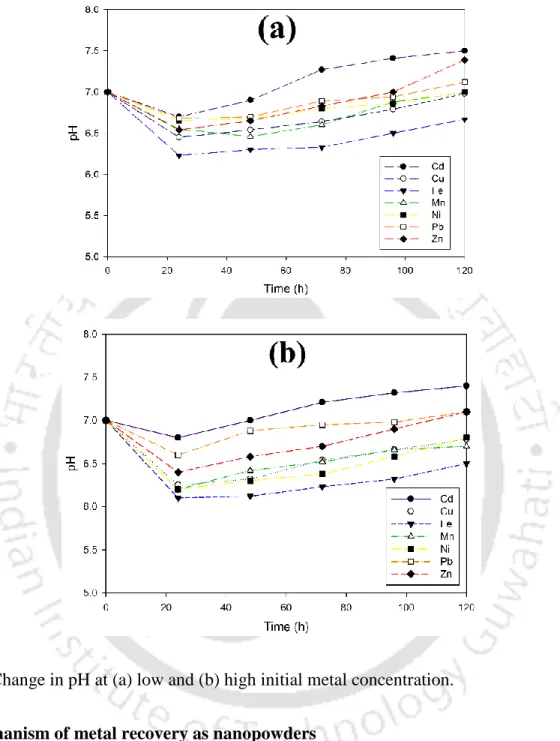Kannan Pakshirajan, Department of Life Sciences and Bioengineering, for his encouragement, support and constant monitoring of the progress of my research. The particle size distribution of the various metal nanoparticles is shown as inset to these figures.
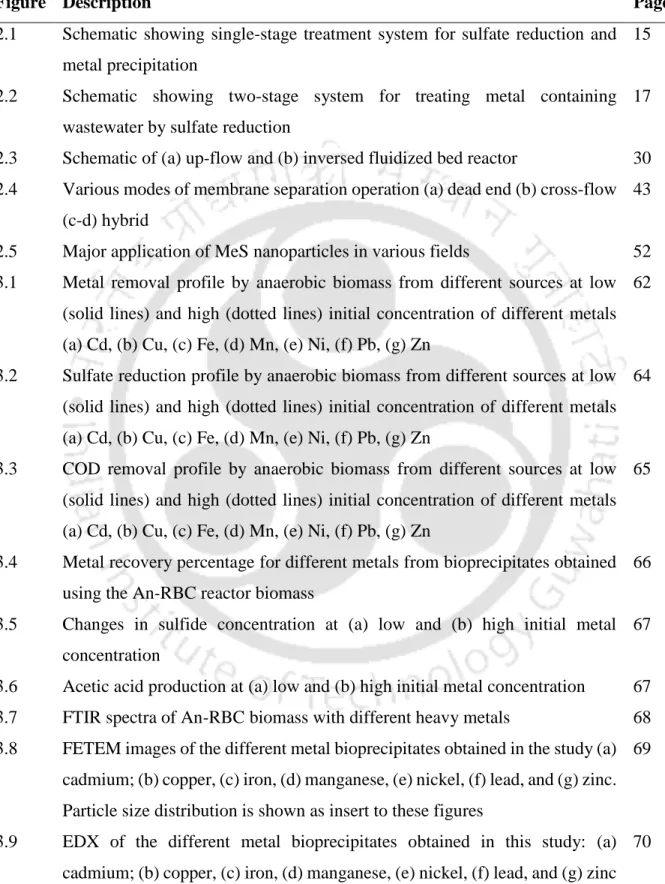
Introduction
General introduction
Aim and objectives
Screening of anaerobic biomass collected from different sources for heavy metal removal and recovery under sulfate reducing condition. Performance evaluation of sulfidogenic inverse fluidized bed reactor system for heavy metal removal and recovery.
Organization of thesis
Preparation, characterization and application of biometric nanopowders from metallic wastewater for the removal of azo dyes from aqueous solution. The preparation, characterization and application of biometric nanopowders from metal wastewater for azo dye removal from aqueous solution are reported in Chapter 6.
Literature review
Heavy metals
- Sources of heavy metals in environment
- Environmental effects of heavy metal containing wastewater
Some heavy metals, such as iron, cobalt, zinc, etc., are considered essential nutrients in very small amounts, while other heavy metals, such as cadmium, mercury, and lead, are highly toxic even in very small amounts (Kieu et al., 2011). Electroplating and coal-fired power plants generate a significant amount of wastewater containing various heavy metals such as copper, cadmium, lead, nickel, zinc, chromium, etc.
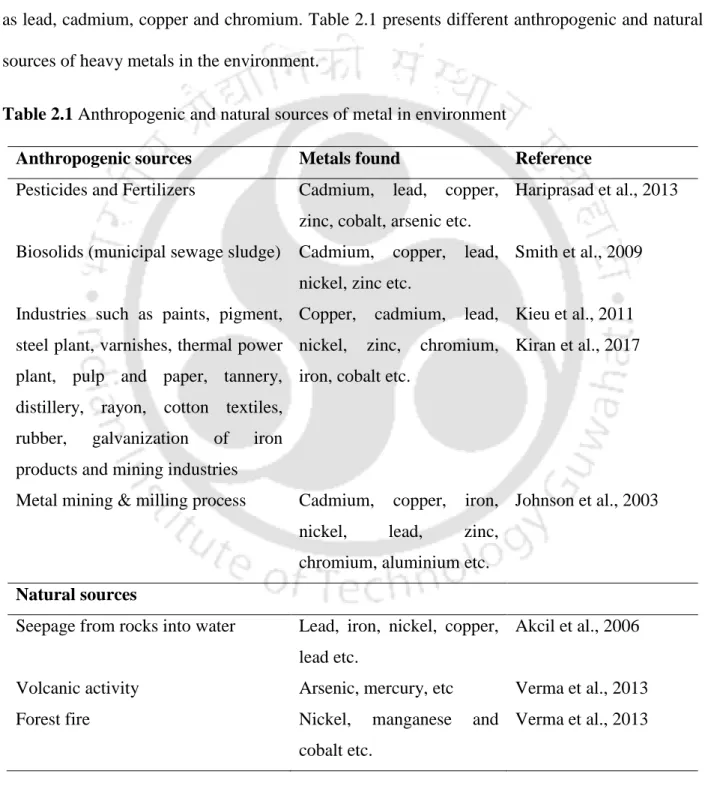
Metal removal
- Metal removal by Physico-chemical process
- Metal removal by biological sulfate reduction
- Single stage reactor systems for metal removal
- Two-stage or multi stage system for metal removal
For simultaneous sulfate reduction and metal removal in a single-stage bioreactor system, the lowest influent pH of 5.0 has been reported (Sahikaya and Gungor et al., 2010). Although metals can be recovered from the metal sulphide containing sludge, this involves loss of biomass (Tabak et al., 2003).
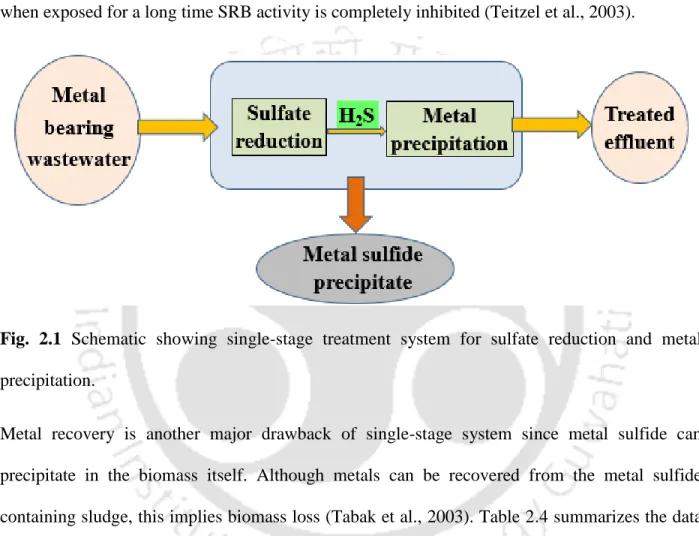
Metal recovery by biological sulfate reduction
- Metal recovery in a single-stage system
- Metal recovery in two-stage or multistage system
- Single-stage vs multi-stage system
Therefore, to exclude the salts present in the TSS for the calculation of the metal recovery value, Villa-Gomez et al. 2011) acidified the recovered solids prior to analysis of the metals present. Furthermore, the single-stage system has low surface area requirements, but the main advantage of the multi-stage system is the easy and selective recovery of metals (Tabak et al., 2003).
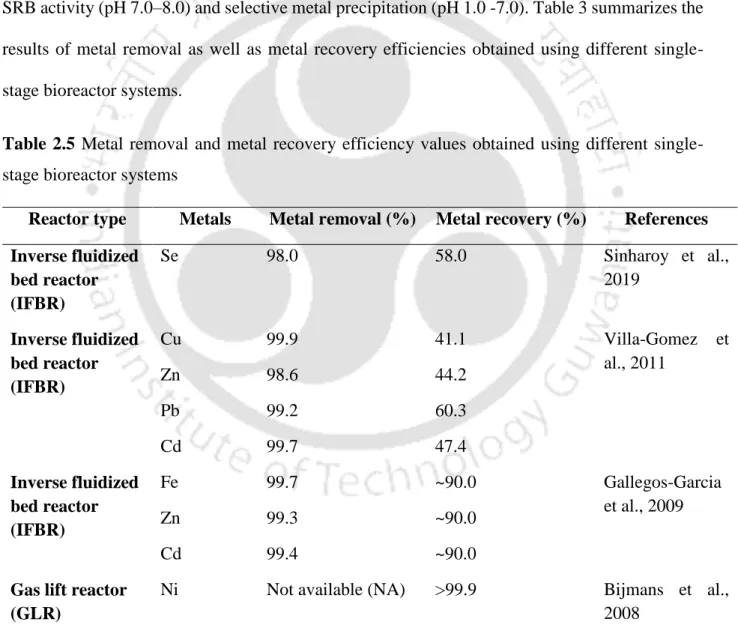
Selection of sulfidogenic bioreactor for metal removal and recovery
Copper sulfide nanoparticles (CuS NPs) find several applications in the biomedical field, which include the detection of foodborne pathogens, biomolecules (DNA), glucose, etc. (Cai et al., 2014). Maximum dye sorption capacity of the column (qe(exp)) was calculated by the ratio between the amount of adsorbed dye (qtotal) (mg) and the amount of adsorbent used in the column (W) (g) (Ajmani et al., 2020) .
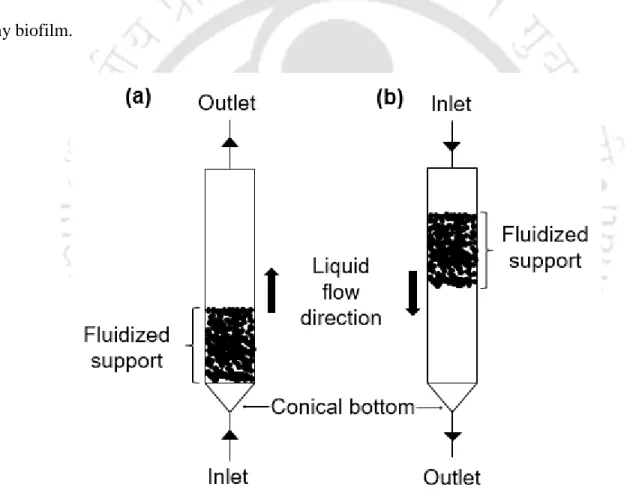
Effect of key factors on metal removal and recovery in sulfidogenic
- Reactor pH
- Other influent parameters
- Reactor design and operating conditions
Attached growth sulfidogenic bioreactors, bioprecipitate characterization
- Conventional purification methods for metal sulfide precipitates…
- Membrane based separation for purification of metal sulfide
- Membrane Modules
- Membrane materials
- Polymer vs. Ceramic membranes
The biofilm enables sulfide production, metal sorption, mineral precipitation (Konhauser et al., 1993) and plays a key role in the formation of metal sulfide nanoparticles. However, metal sulfide nanoparticles bound to exopolysaccharide (EPS) secreted by SRB are found around the cell wall (Kiran et al., 2017). Conventionally, solid-liquid separation is performed using gravity clarifiers (thickeners) or filters (Estay et al., 2020).
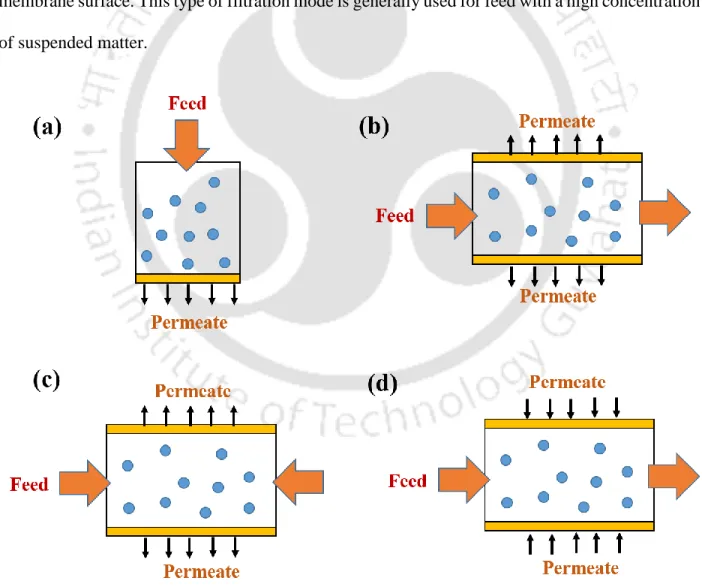
Applications of metal sulfide nanoparticles
- Solar Cells
- Biomedical applications
- Agriculture
- Electronics
- Bioactive coatings
- Catalytic Reactions
- Environmental remediation
- Fuel cells
These nanoparticles were also used for the evaluation of antifungal activity against some phytopathogenic fungi (Sidhu et al., 2017). CuS NPs are also effective as wound dressings and stockings due to their biocidal properties (Borkow et al., 2009). CuS NPs have been used as catalysts due to their low toxicity, affordability and regeneration (Rubilar et al., 2013).
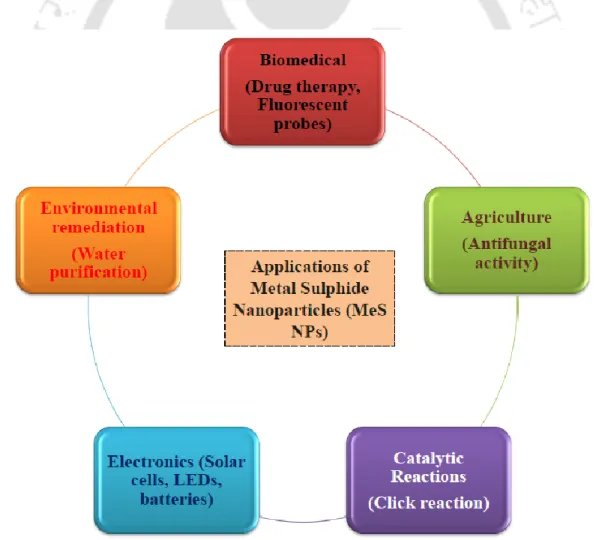
Screening of anaerobic biomass collected from different sources for heavy
Introduction
To compensate for this loss, heavy metals need to be recovered from wastewater discharged by industries, especially mining and metallurgy, which typically contain a high concentration of heavy metals (Kiran et al., 2018). Thus, there is increasing interest in the potential application of biological sulfate reduction as an alternative method for removing and recovering heavy metals from wastewater (Castillo et al., 2012; Sanchez-Andrea et al., 2014; Lefticariu et al., 2015) . For example, nanoparticles of nickel sulfide and copper sulfide can be used for dye degradation (Molla et al., 2016; Shamraiz et al., 2016) and nanoparticles of iron sulfide can be used for reduction of chlorinated organic compounds and removal of heavy metals (Gong et al. , 2016).
Materials and methods
- Screening of anaerobic biomass for heavy metal removal and
- Metal nanoparticle characterization
- Analytical methods
Samples processed similarly to FTIR analysis were used for FESEM-EDX analysis (Zeiss, Sigma, Germany) to verify the morphology of metal precipitates. To verify the internal structure and morphology of metal precipitates by FETEM analysis, control and metal-loaded biomass were centrifuged three times at 5600 × g for 10 min each, followed by washing with distilled water after each run. To determine the percent metal recovery in this study, the metal precipitates were first collected by decanting the supernatant, and then the precipitate was acidified with 20% HNO3 to ensure complete dissolution of the metal precipitates.
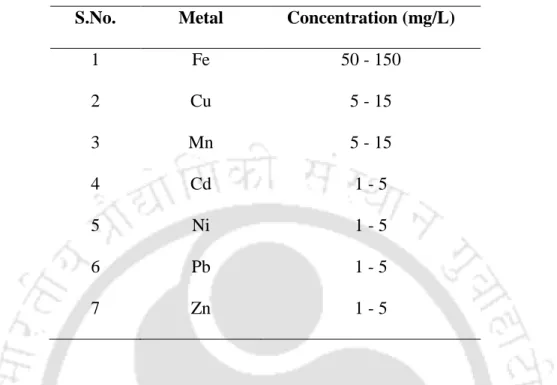
Results and discussion
- Heavy metal removal
- COD and sulfate removal
- Heavy metal recovery
- Sulfide and VFA production
- Characterization of metal bioprecipitates
- Mechanism of sulfate reduction and heavy metal removal
- Mechanism of metal recovery as nanopowders
The results of sulfate reduction and COD removal by anaerobic biomass in the presence of various metals at low initial concentration are shown in fig. These fine and colloidal particles can contribute to residual metals in the effluent (Villa-Gomez et al., 2011). In addition, alkalinity resulting from lactate/acetate metabolism by SRB present in the biomass may contribute to the removal of heavy metals (Goncalves et al., 2007; Neculita et al., 2007).
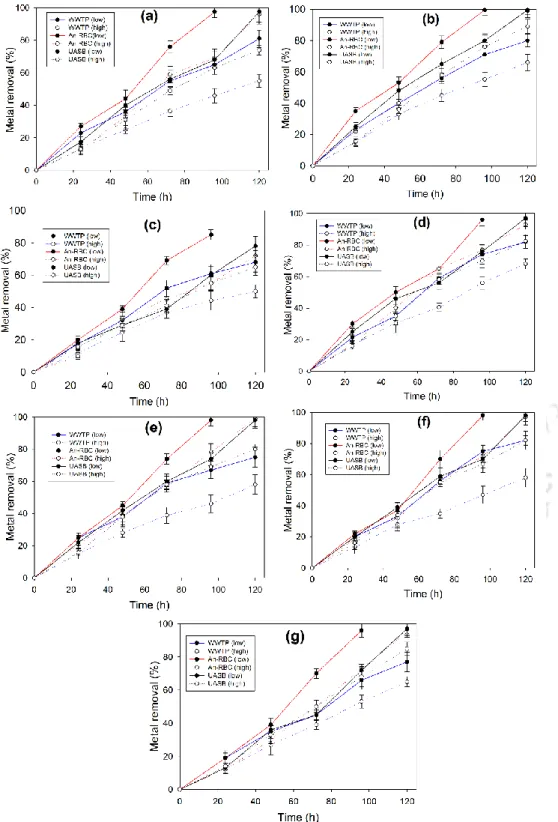
Significant findings
In this study, the formation of these metal sulfides on the outer surface of the bacterial cell wall was confirmed by EDS peaks (Fig. 3.12c). Furthermore, the presence of individual metal and sulfide peaks in the EDX spectra and XRD patterns of the bioprecipitates confirmed the presence of metal sulfide in the bioprecipitates (Fig. Based on the results, a schematic view of the detailed mechanism involved in metal sulfide nanoparticle formation by SRB is depicted in fig.
Performance evaluation of a sulfidogenic inverse fluidized bed reactor system
Introduction
In turn, these heavy metals should be recovered for industrial reuse applications (Kiran et al., 2018). Low wastewater pH directly affects the recovery of heavy metals unfavorably by dissolving metal sulfide (Zhang et al., 2018). Not only pH, but also other factors, including hydraulic retention time (HRT), metal loading rate, and sulfide concentration can affect metal recovery in the IFBR system (Villa-Gomez et al., 2011).
Materials and methods
- Sulfate reducing biomass
- Synthetic wastewater composition
- IFBR and start up
- Effect of HRT
- Experimental procedure for metal removal and recovery
- Characterization of immobilized biomass and metal
- Calculations
For the estimation of the amount of metals recovered in the reactors, metal bioprecipitates that settled at the bottom and the equalizer part of the reactors were collected and dissolved by acidification with 20% HNO3 (Villa-Gomez et al., 2011). Where Min and Malt are metal concentrations (mg/L) in the influent and effluent to the reactors, respectively (Villa-Gomez et al., 2011). Where Mb and Meq are metal concentrations (mg/L) in the bioprecipitates collected from the bottom and equalizer section of the reactors and Mtotal is the total metal concentration (mg/L) in the influent (Villa-Gomez et al., 2011).
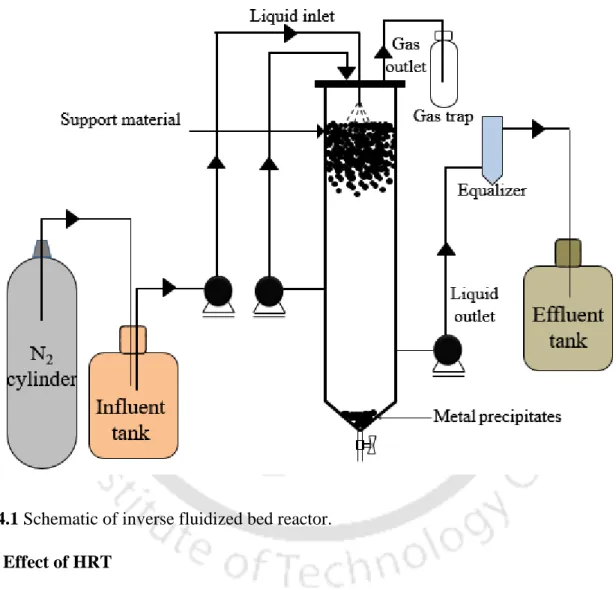
Results and discussion
- Characterization of immobilized biomass
- Effect of HRT for metal removal
- Heavy metal removal
- Effect of heavy metals on sulfate reduction and COD removal
- Metal recovery
- Bioprecipitate characterization
- Heavy metal removal, sulfate reduction, COD removal and sulfide
- Metal sulfide recovery as nanopowders
- Role of SRB in metal sulfide nanoparticle recovery
The metal-sulfide ratio (M/S2−) is known to play an important role in the SRB-mediated metal removal process (Kiran et al., 2017). In both reactors, an increase in inlet pH was observed due to bicarbonate ions produced and acetate consumption for sulfate reduction by SRB (bar. Garcia et al., 2009).
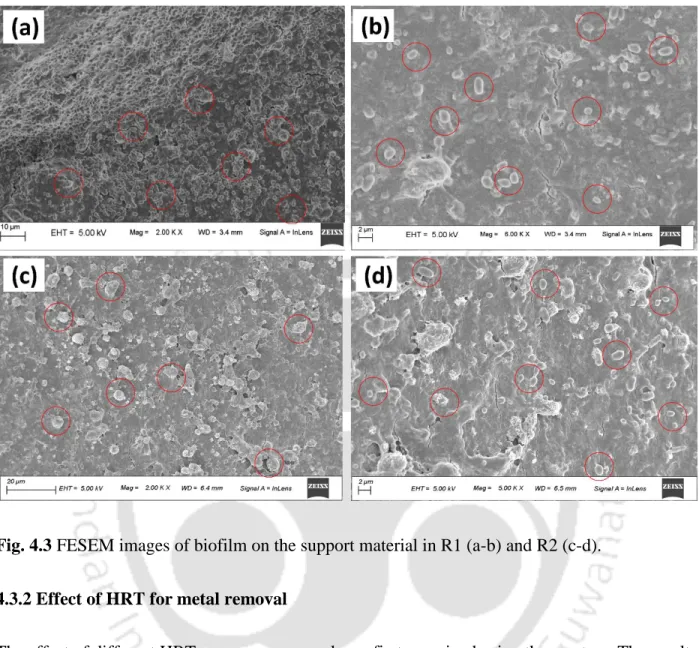
Significant findings
Purification of biogenic copper sulfide nanoparticles by microfiltration using
Introduction
Metallic wastewaters such as acid mine drainage (AMD) generated by coal mines and mining-related operations are characterized by a low pH and contain a high concentration of metals, sulfates, and low COD (chemical requirements for oxygen) (Kiran et al., 2017; Singh et al., 2020). The single-stage sulfidogenic inverted fluidized bed reactor (IFBR) system can be used to efficiently recover bioprecipitate (Paul et al., 2020). However, metal sulfide nanoparticles in bioprecipitates are found attached to exopolysaccharide (EPS) secreted by SRB around the cell wall (Kiran et al., 2017).
Materials and methods
- Raw materials
- Synthesis and pretreatment of copper sulfide nanoparticles (CuS
- Purification of CuS NPs by microfiltration
- Characterization of CuS NPs
- Determination of biomass and copper concentration
To perform the membrane pure water permeation test, a dead-end filtration setup (400 mL capacity) was used (Fig. 5.2). The membrane was placed on the bottom and a neoprene "O" ring was squeezed on top of the membrane to prevent any leakage. Filtration was effected by N2 gas purging to the desired pressure on top of the membrane.
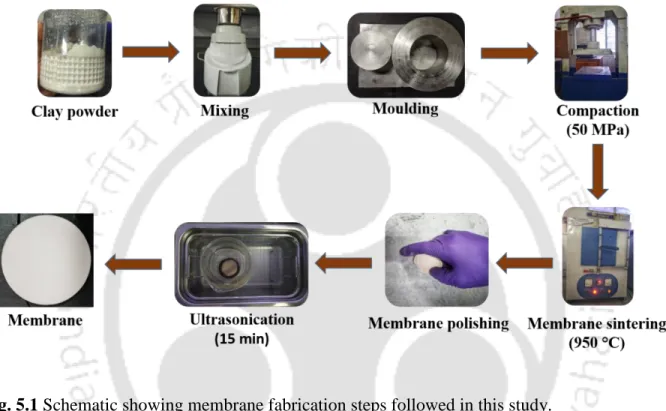
Results and discussion
- Membrane characterization
- Pure water permeation test
- CuS NPs purification by microfiltration
- Characterization of CuS NPs
- Analysis of membrane cost for CuS NPs purification
The diffraction peaks of the XRD pattern indicate the crystalline nature of CuS NPs (Nezamifar et al., 2015). Regeneration of the dye-loaded MeSNPs in the column was achieved by passing 2 M sodium hydroxide solution and analyzed for up to four continuous sorption-desorption cycles (Ajmani et al., 2020). The volume treated and the removal efficiency of the dyes also decrease with an increase in the flow rate.
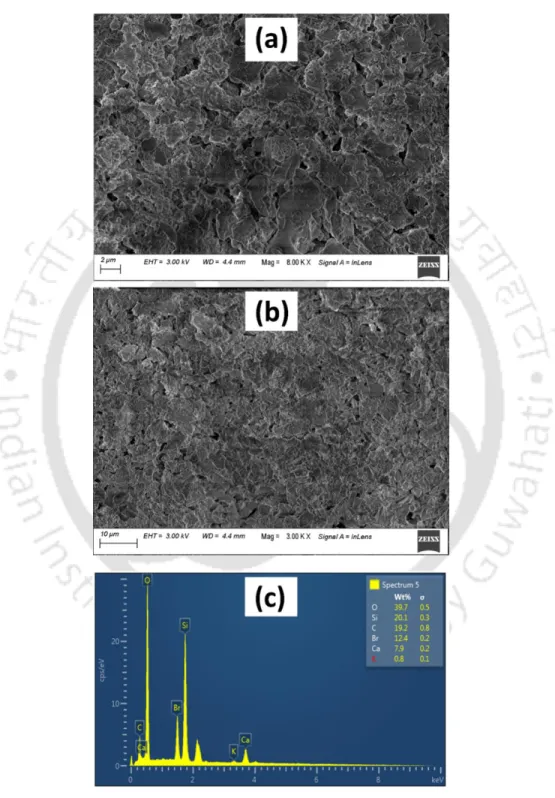
Significant findings
Synthesis and characterization of biogenic metal sulfide nanoparticles from
Introduction
Examples of the main chromophores are: carbonyls, nitrile, esters, ethylene, acetylene and acids, and chromogenic are the compounds they carry (Kumar et al., 2018). Various physico-chemical and biological methods, such as biodegradation, ion exchange, Fenton oxidation, adsorption, etc., have been investigated to treat dye-containing wastewater (Samsami et al., 2020). Several nanomaterials have been reported to remove contaminants from various types of wastewater, including for the removal of dyes (Singh et al., 2020).
Materials and methods
- DR 80 and MB 9
- Synthesis and characterization of biogenic MeSNPs
- Batch adsorption experiments
- Adsorption isotherm
- Adsorption kinetics
- Dye desorption test
- Continuous dye removal experiments
To analyze the adsorption isotherm of DR 80 and MB 9, different concentrations of the dyes in the range of 50-300 mg/L were taken in water (100 ml) in Erlenmeyer flasks and then added with 200 mg of MeSNPs. The flasks were incubated for 48 hours at constant room temperature (25-27°C) in an orbital shaking incubator to reach equilibrium, and the residual dye concentration at the end of the experiment was determined. A desired amount of MeSNPs was packed in the column between glass wool and glass beads to hold the adsorbent in place.
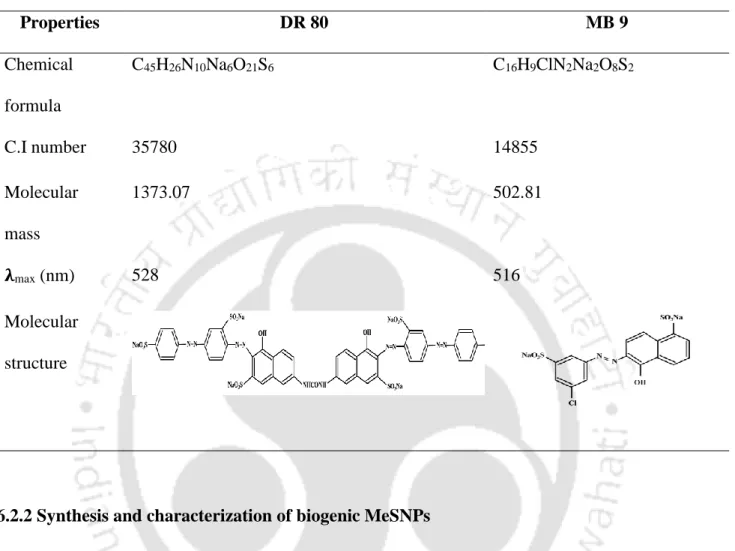
Results and discussion
- MeSNPs characterization
- Effect of different variables on dye removal
- Contact time
- Effect of MeSNPs dosage
- Effect of solution pH
- Effect of initial dye concentration
- Continuous dye sorption using fixed-bed column
- Dye desorption
The effect of different pH values on the adsorption efficiency of DR 80 and MB 9 with MeSNP was evaluated. Three commonly used isotherm models (Langmuir, Freundlich, and SIP) were used to characterize the batch adsorption of DR 80 and MB 9 by MeSNPs. A comparison of MeSNPs with other adsorbents reported in the literature for the removal of DR 80 and MB 9 reveals their better performance compared to others (Table 6.1).
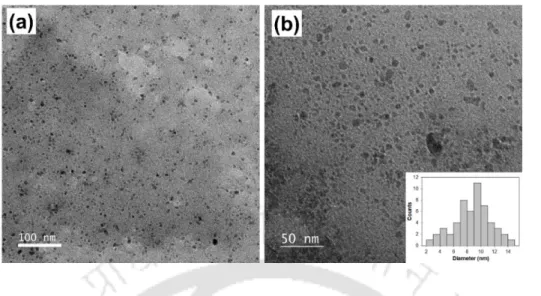
Significant findings
These results reveal a drastic reduction in the adsorption capacity of MeSNPs towards the end of four adsorption-desorption cycles, which may be due to deactivation of the binding sites present in the adsorbent, as reported by Thabede et al.
Green synthesis and application of biogenic copper sulfide nanoparticles from
- Introduction
- Materials and methods
- Chemicals
- Synthesis of copper sulfide nanoparticles
- Immobilization of CuNPs
- Synthesis of 1,2,3‑Triazoles
- Recycling of catalyst
- Characterization techniques
- Results and discussion
- Characterization of CuNP immobilized PVA beads
- Selection of parameters for click reaction
- Synthesis of the Triazoles
- Mechanism
- Recycling of the catalyst
- Significant findings
A mixture of 1,4- and 1,5-disubstituted compounds is obtained as a result of the Huisgen cycloaddition reaction, which requires (1) high temperature, (2) long reaction time, and (3) electron-withdrawing solid substituents (Gholinejad et al., 2020) ). One such polymer is agarose, which was successfully used as a binding polymer in click reaction for triazole production (Gholinejad et al., 2020). PVA-based copper nanoparticles have been synthesized and used as nanoparticle stabilizers (Saez et al., 2009; Hammad et al., 2015).
Induced oxidative stress in Rhodococcus opacus due to biogenic and chemical
Introduction
Materials and methods
- Rhodococcus opacus and seed culture cultivation
- PbS NPs and CdS NPs
- Biogenic nanoparticles
- Chemical nanoparticles
- Effect of PbS and CdS nanoparticles on biomass growth and lipid
- Characterization of R. opacus biomass and metal nanoparticle 191
- Intracellular hydroxyl radical (oxidative stress) measurement 192
Results and discussion
- Characterization of PbS NPs and CdS NPs
- Binding and uptake of metal nanoparticles by R. opacus PD 630…
- Nanoparticle induced oxidative stress in R. opacus PD 630
Significant findings
Summary and conclusions
